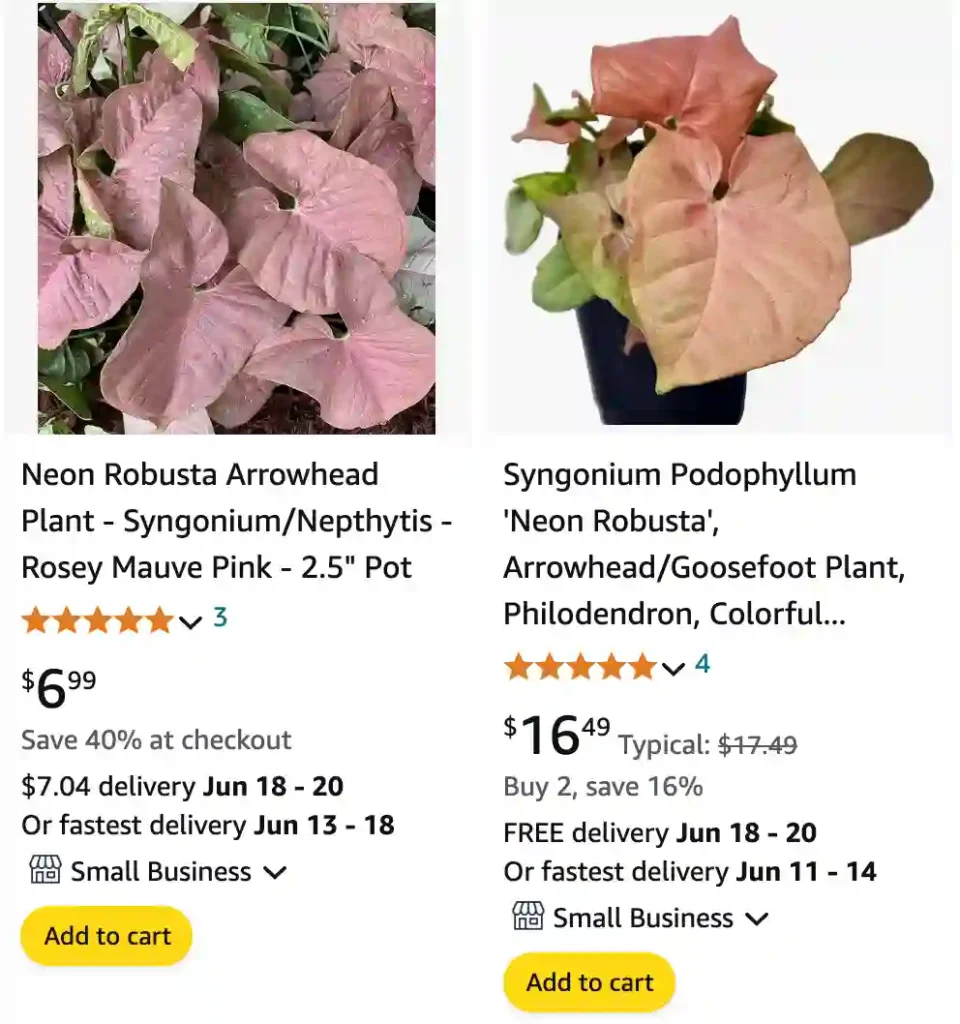
Syngonium Neon Robusta: Your Guide to the Pink Arrowhead Plant
Hey there, plant enthusiasts! Ferb Vu here, and today we’re diving into the world of the stunning Syngonium Neon Robusta, also known as the Pink Arrowhead Plant. This vibrant climber has captured hearts with its unique foliage and easygoing nature.
Whether you’re a seasoned plant parent or just starting your indoor jungle, this FAQ will equip you with everything you need to know about caring for your Syngonium Neon Robusta.
What is a Syngonium Neon Robusta?
The Syngonium Neon Robusta is a captivating variety of the Syngonium podophyllum, or Arrowhead Plant. It boasts heart-shaped leaves, characteristic of the Arrowhead family, with a stunning light green base blushed with a vibrant pink hue.
This tropical wonder hails from the rainforests of Central and South America, bringing a touch of the exotic to your home.
Syngonium Neon Robusta vs Pink Allusion
Syngonium Pink Allusion, on the other hand, has a more delicate, watercolor-like pink. It tends to be concentrated in the veins and edges of the leaves, with a softer green filling the center. This creates a beautiful contrast that reminds me of a springtime flower. Mine grows in a more vining way, sending out long, elegant stems that look fantastic trailing or climbing a moss pole.
Is the Syngonium Neon Robusta Easy to Care For?
Absolutely! The Syngonium Neon Robusta is a low-maintenance plant, perfect for busy schedules or those new to the world of houseplants. It thrives with minimal fuss, making it a fantastic choice for beginners.
Here’s a quick rundown of its basic needs:
- Light: Bright, indirect sunlight is ideal. Avoid harsh, direct sun, which can scorch the leaves.
- Water: Water your Syngonium Neon Robusta when the top inch or two of soil feels dry. Overwatering can lead to root rot, so err on the side of underwatering.
- Humidity: While it tolerates average household humidity, it appreciates a boost, especially in drier climates. Grouping plants together or using a pebble tray filled with water can help increase humidity.
- Soil: Well-draining potting mix is key. Look for a mix specifically formulated for houseplants or aroid plants.
How Big Does a Syngonium Neon Robusta Get?
As a vining plant, the Syngonium Neon Robusta has the potential to reach impressive heights. With proper care and support, it can climb several feet. However, its growth can be easily controlled by pruning.
How Do I Make My Syngonium Neon Robusta Climb?
Providing your Syngoniom Neon Robusta with a moss pole or trellis will encourage it to climb and showcase its cascading vines. Simply train the aerial roots to attach to the support structure as it grows.
Syngonium Neon Robusta vs. Syngonium Podophyllum: What’s the Difference?
The Syngonium Neon Robusta is a specific cultivar of the Syngonium podophyllum, the common Arrowhead Plant. The main difference lies in the foliage. The Syngonium podophyllum typically has solid green leaves, while the Neon Robusta features the captivating pink blush.
In terms of care, both varieties share similar needs. However, the Syngonium podophyllum may tolerate slightly lower light conditions compared to the Neon Robusta, which prefers brighter indirect light.
Syngonium Neon Robusta vs. Philodendron: Telling Them Apart
While both Syngonium Neon Robusta and Philodendrons are popular houseplants with heart-shaped leaves, they belong to different plant families (Araceae for Syngonium and Araceae for Philodendron). Here’s a quick comparison to help you distinguish them:
- Leaves: Syngonium leaves tend to be thinner and glossier than Philodendron leaves. Additionally, Syngonium leaves often have more prominent lobes, giving them a more defined “arrowhead” shape.
- Leaf Veins: Philodendron leaves typically have prominent, visible veins, while Syngonium leaves may have less noticeable veins.
- Growth Habit: Syngonium Neon Robusta is a vining plant, while many Philodendrons are bushy or climbing varieties.
Propagation: Can I Grow More Syngonium Neon Robusta?
Absolutely! The Syngonium Neon Robusta propagates readily through stem cuttings. Here’s a simple method:
- Take a healthy stem cutting with at least one node (the bump where the leaf meets the stem).
- Remove the lower leaves, leaving a couple of nodes exposed.
- Place the cutting in water or a well-draining potting mix.
- Keep the soil or water moist and provide bright, indirect light.
- Roots should develop within a few weeks. Once established, pot your new Syngonium Neon Robusta in a suitable container.
Common Syngonium Neon Robusta Problems
While generally a trouble-free plant, a few issues can arise:
- Brown Leaves: Overwatering is the most common culprit. Ensure the soil dries slightly between waterings.
- Yellowing Leaves: This can indicate underwatering, nutrient deficiency, or insufficient light. Check the watering schedule and adjust if needed. If underwatering isn’t the cause, consider fertilizing your Syngonium Neon Robusta once a month during the growing season with a diluted balanced fertilizer. Lastly, ensure it receives adequate bright, indirect sunlight.
- Leggy Growth: This signifies insufficient light. Move your plant to a brighter location.
- Pests: Mealybugs and spider mites can occasionally be a nuisance. Regularly inspect your plant and treat infestations with neem oil or insecticidal soap.
By following these simple tips, you can keep your Syngonium Neon Robusta thriving and adding a touch of vibrant pink to your indoor space.




